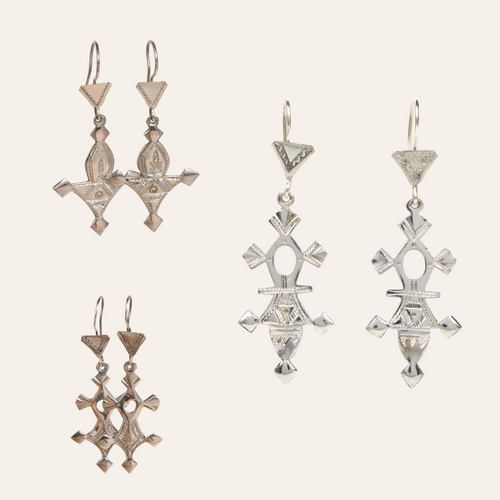
21 Cross Symbols of the Tuareg

www.symbolminded.com
The Tuareg silver pendant, known as the Southern Cross or the Cross of Agadez, is one of the most iconic pieces of jewelry attributed to the Tuareg people. It should be noted, however, that the term "cross" is a European label with no equivalent in the Tamasheq language. The Tuareg typically refer to the cross as teneghelt, derived from the verb enghel, which means "to pour"—a reference to the lost-wax casting method used to create these pieces. I’ve highlighted the details of this jewelry-making technique in a previous blog post titled "Lost Wax Casting and Jewelry Making"

Lost Wax Casting and Jewelry Making
Some of the lore surrounding the Tuareg cross has been chronicled in a previous blog post named "The Tale of the Teneghilt". This tale of the origin and meaning of all teneghelt belongs to a rich tapestry of understanding and ritual behavior. It reinforces the bonds between aristocrats and Inadan (silversmiths/artisans) as brothers and companions from their earliest years as childhood friends. The tale attributes the invention and creation of a powerful love symbol to the Inadan, who combine the masculine and feminine symbols (+ and O) into a sacred and beautiful silver object—a noble, "pure" metal. The founding legend also elaborates on the eternal bonds linking the chivalrous prince, the artisan, the beloved woman, and her companion, the servant, weaving these ties into a powerful symbolism of constancy and love that shape relationships beyond authority and domination. Its sacred dimension permeates all aspects of Tuareg cultural understanding.

Mystics and Sages Tuareg Cross Earring Designs
The Teneghilt became the ancestor and prototype of all silver jewelry in Tuareg lore. It has been at the center of intimate jousts and of community rituals held on festive occasions, which marked collective engagement. Today, it also figures on the coat of arms of the Republic of Niger.
The Indanes, the Tuareg artisans who fashion this unique style of silver jewelry generally belong to a long tradition that has defined their function and social status in the community, and quite often are the repository of much symbolic knowledge which has been passed from father to son in certain families. Metal workers and smiths are traditionally known to have mastery over fire and formidable spiritual powers. Not only did they once provide their noble patrons with finely chiseled ornaments and fine swords, but they also were the ones who recited oral epics and praise songs, and thus maintained the history of the group. Even today, the traditional client-patron relationship between nobles and artisans remains intact in some rural areas.

